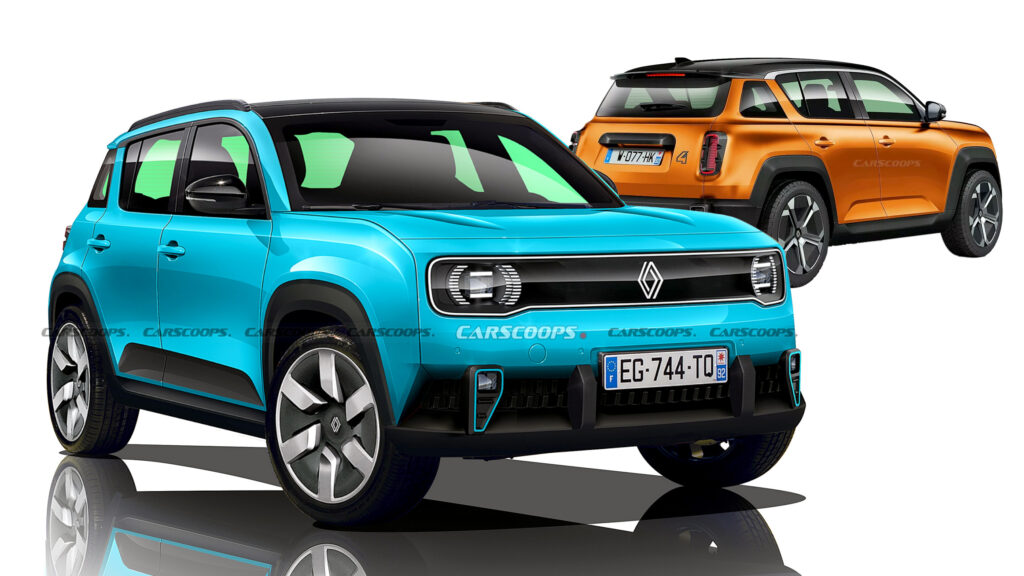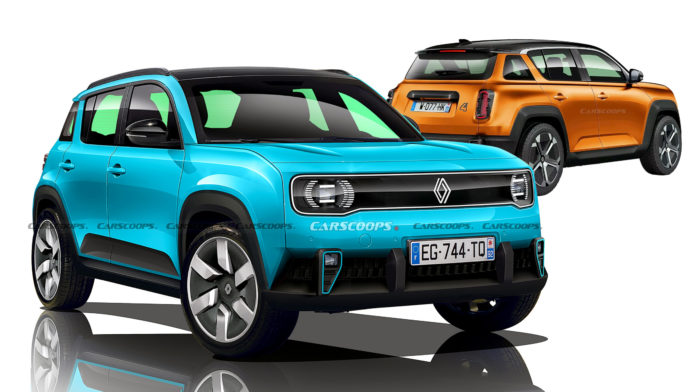The electric crossover will share its CMF-BEV platform with the new R5 hatchback and will also spawn an LCV variant

The illustrations in this story are not affiliated with or endorsed by Renault. Furthermore, we have updated the article with new renderings and the most recent information available on the EV (10/7).
Renault is gearing up to expand its EV lineup with two retro-inspired models: the R5 supermini and the 4 crossover. While the latter isn’t anticipated to hit production until 2025, we’ve already gathered substantial details about its design and technical specs. In this article, we’ve compiled all the information available on the upcoming EV, complemented by a set of exclusive renderings providing an in-depth look at its design.
The French carmaker announced the 4 as part of its electrification strategy in June 2021, showcasing the grille, lighting signature, and silhouettes of the passenger and LCV variants of the modern interpretations of the iconic 4L hatchback (1961-1992) and the equivalent 4 Fourgonette (1965-1992) van. However, the most revealing preview of the upcoming production model was the Renault 4Ever Trophy Concept which debuted in Paris in October 2022. This study gave us a better idea of the production model’s rugged styling and budget-oriented character.
advertisement scroll to continue
Read: Everything We Know About The 2024 Renault Espace 7-Seater Hybrid SUV
Jean Francois Hubert/SB-Medien for CarScoops
Our artist has created a pretty accurate representation of the 2025 Renault 4 crossover based on the official teasers and last year’s concept. The front and rear three-quarter renderings borrow the main body and styling cues of the concept, albeit with some toned-down features for production. These are likely to include smaller diameter wheels, conventional mirrors and door handles, a more discreet body kit, and the omission of the extreme off-road equipment of the concept, as well as the futuristic hollow bonnet which sacrifices practicality.
The simple black grille that encloses the LED headlights, the greenhouse, the vertically-mounted taillights, the shape of the pronounced fenders, the trapezoidal rear side windows, and the tapered tail with the pill-shaped taillights are clear references to the original 4L and will most likely make it to production. At the same time, the generous ground clearance, the heavy dose of plastic cladding on the boxy wheel arches, and the large unpainted sections on the bumpers give it a more adventurous stance in line with rugged SUVs like the Dacia Duster stablemate.
Dimensions, Interior And Tech
The 4 is expected to closely mirror the concept’s footprint, with a length of 4,160 mm (163.8 inches) and a 2,570 mm (101.2 inches) wheelbase, placing it in the B-SUV segment. This would make it almost half a meter (19.6 inches) longer than the original 4L from the ’60s but 68 mm (2.7 inches) shorter than the ICE-powered Captur which is currently the smallest SUV in Renault’s European range.
The interior of the Renault 4 is expected to reflect the no-frills character of the exterior, with a minimalist design that emphasizes practicality and durability. Despite its compact size, the electric platform is expected to result in a five-seater cabin and a large boot for the segment. We wouldn’t be surprised if Renault takes a cue from Dacia and incorporates a smartphone stand, along with a smaller-than-usual digital cockpit and recycled materials, in order to make the 4 more affordable and sustainable. This strategy is also being followed by rival French brand Citroen, showing a growing trend among automakers.
Renault’s approach of blending retro and modern design elements will be limited to the R5 and 4 models, differentiating them from the rest of the lineup. As described by Renault Group Chief Design Officer Laurens van den Acker, this decision is similar to the strategy used by Ford for the Mustang and Bronco nameplates, allowing designers to “tell stories from the past”. Other EVs that draw on their automaker’s legacy in terms of styling include the Fiat 500e, Honda e, and MINI Cooper SE.
The Renault 4 will be built on a stretched version of the CMF-BEV architecture that will also underpin the R5, the Alpine A5 hot hatch, and the electric successors of the Nissan Micra and Juke. Although we don’t have information about the power of the electric powertrain (most likely a front-mounted motor) or the battery capacity, Renault has previously hinted at a WLTP range of up to 400 km (249 miles). We also know that the new low-cost batteries will feature nickel, manganese, and cobalt technology (NMW) and will be produced in France, just like the Renault 4, which will be manufactured at Renault Group’s ElectriCity hub.
The R5 supermini and 4 crossover will be the zero-emission equivalents of the ICE-powered Clio and Captur, occupying the B-Segment when they arrive within the next two years. These retro-flavored EVs will join the Megane E-Tech and the upcoming Scenic E-Tech in Renault’s future passenger EV range, while the 4 Furgonette van will sit alongside the Kangoo E-Tech and Master E-Tech light commercial vehicles.
Renault 4ever Trophy Concept
Stefan Baldauf / Guido ten Brink for CarScoops

